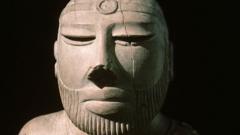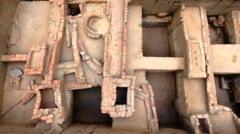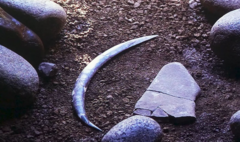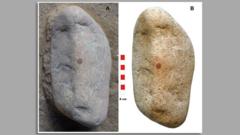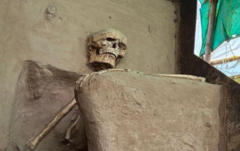The Indus script, an ancient form of writing associated with one of the world's earliest urban societies, has eluded deciphering for generations despite the fervent efforts of historians, linguists, and archaeologists. Weekly, Rajesh PN Rao, a notable researcher and computer scientist, receives messages from individuals of diverse backgrounds—engineers, retirees, and tax officers—who believe they have already cracked the code. These enthusiasts, primarily of Indian origin, impulsively declare they have completed the riddle surrounding the intricate blend of symbols and signs central to the Indus Valley Civilization.
Motivating this renewed interest, MK Stalin, the chief minister of Tamil Nadu, recently announced a $1 million reward for anyone capable of decoding this ancient script, thereby intensifying the exploration. The Harappan civilization emerged approximately 5,300 years ago in what is now northwest India and Pakistan. With over 2,000 archaeological sites discovered, its legacy includes urban centers characterized by advanced infrastructure and significant trade. Yet, its decline remains an enigma devoid of evidence suggesting war, famine, or catastrophe.
Asko Parpola, a leading Indologist, emphasizes the noteworthy importance of the script, which remains one of the most significant undeciphered writing systems in history. Several theories have emerged over the years—involving early Indian languages and even Sumerian influences—but a definitive understanding has yet to be achieved. The common belief that these symbols convey spirituality or political ideologies is increasingly dismissed by experts like Mr. Rao, who highlight their apparent association with trade seals.
Challenges abound in cracking this code: a limited corpus of 4,000 symbols, numerous short inscriptions averaging five characters, and a lack of bilingual artifacts akin to the Rosetta Stone, which proved crucial for deciphering Egyptian hieroglyphs. The seals—from which most scripts are derived—often demonstrate a typical design featuring an animal motif and inscrutable symbols.
Meanwhile, contemporary technological advancements are spearheading decoding efforts through machine learning and statistical analysis. Researchers, including Nisha Yadav from the Tata Institute of Fundamental Research, are currently examining digitized datasets of the script. Preliminary findings suggest recognizable patterns; however, ambiguity persists regarding whether the symbols represent whole words, fragments, or complete thoughts.
Further studies have indicated meaningful connections between Indus inscriptions and ancient graffiti found in Tamil Nadu, leading scholars to propose cultural exchanges between these early civilizations. Observers suggest that Stalin's announcement aims to bolster Tamil cultural pride in the face of political competition, notably against the ruling Bharatiya Janata Party (BJP).
Yet, experts remain skeptical that anyone will claim Stalin's prize in the near future. As ongoing research refines our knowledge of the Indus script, the mystery endures, leaving open the tantalizing proposition: What did the people of this ancient civilization seek to communicate?
The quest for understanding the Indus Valley remains bereft of clarity, leaving many answers unfound.
Motivating this renewed interest, MK Stalin, the chief minister of Tamil Nadu, recently announced a $1 million reward for anyone capable of decoding this ancient script, thereby intensifying the exploration. The Harappan civilization emerged approximately 5,300 years ago in what is now northwest India and Pakistan. With over 2,000 archaeological sites discovered, its legacy includes urban centers characterized by advanced infrastructure and significant trade. Yet, its decline remains an enigma devoid of evidence suggesting war, famine, or catastrophe.
Asko Parpola, a leading Indologist, emphasizes the noteworthy importance of the script, which remains one of the most significant undeciphered writing systems in history. Several theories have emerged over the years—involving early Indian languages and even Sumerian influences—but a definitive understanding has yet to be achieved. The common belief that these symbols convey spirituality or political ideologies is increasingly dismissed by experts like Mr. Rao, who highlight their apparent association with trade seals.
Challenges abound in cracking this code: a limited corpus of 4,000 symbols, numerous short inscriptions averaging five characters, and a lack of bilingual artifacts akin to the Rosetta Stone, which proved crucial for deciphering Egyptian hieroglyphs. The seals—from which most scripts are derived—often demonstrate a typical design featuring an animal motif and inscrutable symbols.
Meanwhile, contemporary technological advancements are spearheading decoding efforts through machine learning and statistical analysis. Researchers, including Nisha Yadav from the Tata Institute of Fundamental Research, are currently examining digitized datasets of the script. Preliminary findings suggest recognizable patterns; however, ambiguity persists regarding whether the symbols represent whole words, fragments, or complete thoughts.
Further studies have indicated meaningful connections between Indus inscriptions and ancient graffiti found in Tamil Nadu, leading scholars to propose cultural exchanges between these early civilizations. Observers suggest that Stalin's announcement aims to bolster Tamil cultural pride in the face of political competition, notably against the ruling Bharatiya Janata Party (BJP).
Yet, experts remain skeptical that anyone will claim Stalin's prize in the near future. As ongoing research refines our knowledge of the Indus script, the mystery endures, leaving open the tantalizing proposition: What did the people of this ancient civilization seek to communicate?
The quest for understanding the Indus Valley remains bereft of clarity, leaving many answers unfound.

